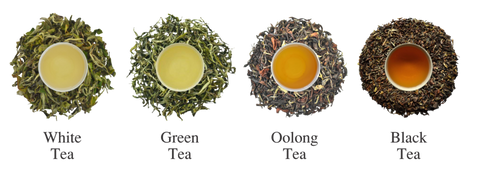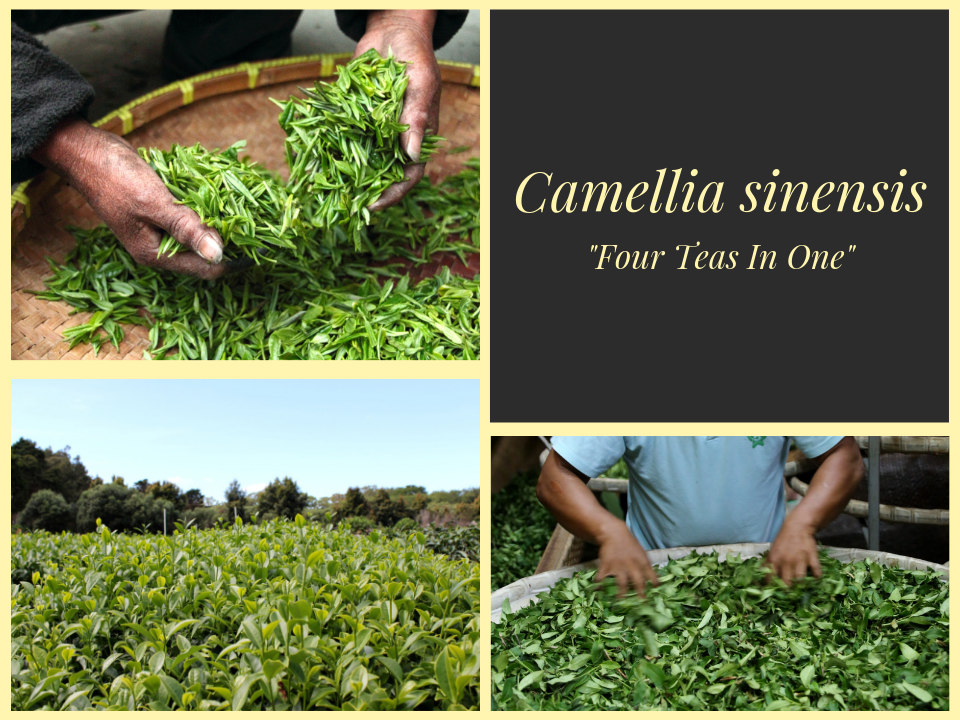Camellia Sinensis - Four Teas in One
Camellia sinensis, the original tea plant, traces back to China (China-jat) and India (Assamica) for nearly 5,000 years. Most of the worldʻs tea is grown in Asian countries like Japan, China, India, Taiwan and Sri Lanka.
Hawaiʻi has joined the fun and is now the newest tea-producing hot spot. Tea was introduced to Hawaiʻi in the late 1800's. Today, thereʻs about two dozen small tea farms in Hawaiʻi.

There are 4 main types of tea: white, green, oolong, and black. But, did you know they all come from the same plant? Itʻs true! Camellia sinensis is the mother of all tea plants. Tea makers use four techniques to create flavor, color and aroma in the cup.

The four techniques in tea making are: withering, oxidation, rolling, and firing.
Imagine picking a flower and leaving it on the table. Over time it wilts and browns. Withering is similar in that it makes the leaves pliable and prepares them for more processing under controlled condition for time, temperature, humidity and light.
Oxidation is when the teaʻs natural enzymes and juices mix with oxygen which deepens the flavor and darkens the color. Some refer to this step as fermentation, but alcohol is not produced. The darker the cup, the higher the oxidation level.
Rolling bruises the leaves to release more enzymes and promote heavier oxidation. Rolling is mainly associated with oolong production.
Firing, aka the kill step, exposes the leaves to heat to kill the active enzymes in the leaf to stop oxidation. This step makes the tea leaves shelf stable. In Chinese tea making, the leaves touch hot metal in the firing step. Imagine a hot giant wok like the ones in Panda Express filled with fresh tea leaves that are quickly, but gently tossed so not to burn.
Yin Zhen Silver Needles Tea
White tea is the least processed tea. Therefore, it has the most delicate color, flavor, and aroma compared to the rest. As leaf buds form on the tea plant, they are covered in white down-like fuzz. The buds are picked and gently fired before withering or oxidation occurs.
Japanese Sencha Green Tea
Green tea may be withered just a touch and there is no oxidation. Japanese tea making uses hot steam to fire the leaves. This creates a greener liquor and grassy flavor. Chinese teas are pan-fired against hot metal giving the cup very different characteristics with floral notes, golden colored liquor and possibly a touch of smokiness like in gunpowder teas.
Honey Oolong
Oolongs can take the longest to make. The freshly picked leaves can be solar withered outside or in climate controlled rooms for many hours. This allows the more mature leaves to soften and oxidize. The withered leaves are gently rolled to further promote oxidization. Some oolongs repeat the rolling-oxidation cycle up to 29 times before the leaves are fired.
Earl Grey Extra Fancy Tea
Black teas are both oxidized and rolled to deepen the flavor and darken the color. This causes the flavor of black tea to be most intense, pungent, and heavier-bodied compared to the other teas.
Processing accounts for 70% of the flavor, aroma and color in the cup. Growing conditions vary from year to year so processing is part science and part art form. The tea maker uses these 4 main techniques of withering, rolling, oxidation and firing to balance flavors, heighten aroma and achieve the greatest joy and satisfaction we get from that cup of tea.






Share:
Limited Edition Cacao Tea A Must Try!
Tea and Aromatherapy for Stress Relief, Better Breathing and Relaxation